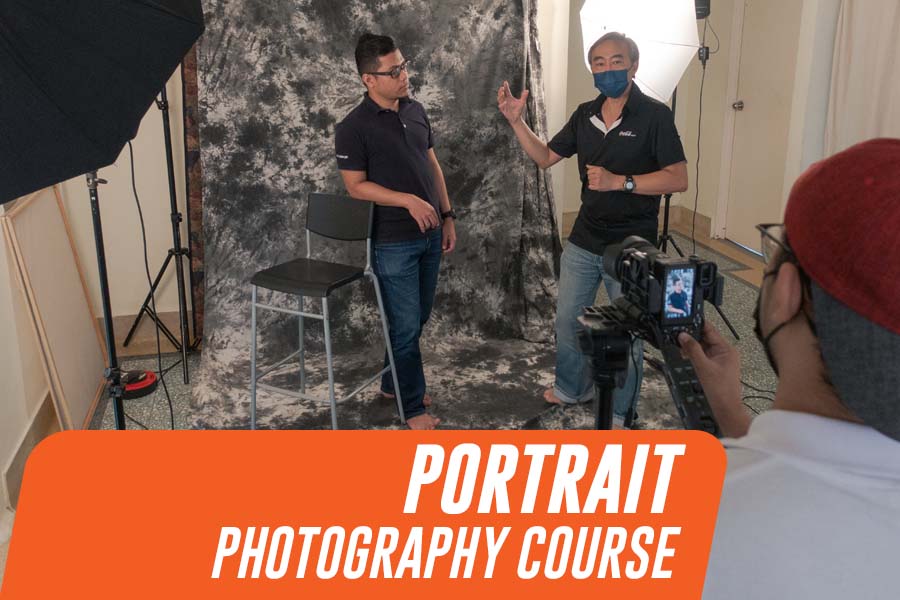
Portrait Photography
The Portrait Photography course is designed to provide learners with the skills and knowledge necessary to capture compelling and expressive portraits. This course covers the essentials of portrait photography, including understanding light and shadows, posing techniques, background selection, and post-processing. Participants will learn how to create impactful portraits that convey the personality and emotion of the subject.
Overview

Portrait Photography
Course Learning Objectives
Course Overview:
This course is designed to provide students with a comprehensive understanding of the principles and techniques of portrait photography. Students will learn how to create visually appealing and effective portraits that capture the essence of their subjects. The course will cover the fundamentals of camera operation, lighting, composition, and posing, as well as more advanced techniques such as creative use of light, shadows, and storytelling.
Course Learning Outcomes (CLOs):
Upon completing this course, students will be able to:
Specific Learning Outcomes (SLOs):
Throughout the course, students will learn to:Assessment:
Assessment will be based on a combination of written assignments, quizzes, class discussions, group critiques, and a final portfolio project. Students will also have the opportunity to receive feedback from their peers and instructors throughout the course.
I hope this helps! Let me know if you have any further questions.

Benefits
With AI, the world is your oyster! It is an emerging field, rapidly growing, ever evolving and watched with a keen eye by industries and markets globally. There are many benefits to an education in AI:
In demand Career
With a Bachelor in artificial intelligence you are equipped with in-demand skills in the rapidly growing field of AI. Knowledge of developing AI systems, data analysis and AI techniques makes you valuable across industries, right from healthcare, finance, tech and more. This degree prepares you for career that has multiple options for diversification. AI professionals include AI engineers, data scientists, machine learning specialists, AI consultants, researchers and more. AI is transformative technology that is revolutionising the world. With an education background in AI, you are set up in an in-demand career field with an exciting future ahead!
Innovation and advancement
Applied AI is all about finding solutions and using AI systems to make life simpler. Applied AI draws on its solid foundation in Computer Science to analyse and provide solutions for real world challenges. You are prepared to address complex problems and contribute meaningfully in domains like healthcare diagnostics, fraud detection, autonomous vehicles, personalised recommendations and more. Being able to apply AI techniques for solving tasks makes for an extremely rewarding and impactful job role!
Solving real world problems
AI aims to constantly bridge the gap between natural intelligence and machine learning - it is a field of cutting edge research, innovation and advancing technology. This makes it ever evolving, with new algorithms, models and techniques being developed. By studying AI at an undergraduate level, you gain a strong foundation in AI fundamentals that help you better understand the latest advancements. You step into a career that empowers you to push the boundaries of AI, contribute to research and development and drive innovation in the field.
100% International
Study at your own pace from anywhere in the world
Recommended by 96% of our graduates
According to our latest alumni survey
50,000+ students
enrolled in Germany’s largest university
Study contents
Contents
I. Understanding Portraits
II. Camera Settings and Equipment
III. Composition and Framing
IV. Lighting for Portraits
V. Working with Your Subject
VI. Post-Processing and Editing
VII. Additional Tips and Tricks
VIII. Famous Portrait Photographers
IX. Practice and Project Ideas
Practice shooting portraits with different camera settings and equipment
Experiment with different lighting setups and environments
Practice directing and posing your subjects (family members, friends)
Create a portfolio or project showcasing your best portrait work
Remember to practice regularly, experiment with different techniques, and study the work of other photographers to improve your portrait photography skills!
Admission
Admissions Criteria
Admission is a crucial aspect of portrait photography, as it allows the photographer to capture the subject's likeness and personality in the most flattering and authentic way possible.
Here are some tips for taking great portrait photos:
Some popular techniques for capturing great portraits include:
Remember, practice makes perfect! The more you shoot portraits, the more comfortable you'll become with posing, lighting, and composition.
Tips for taking great portraits at home:
Careers
Start your Career now
Student reviews
Coming Soon.
Tuition fees
All our study programmes include the following benefits
- Teaching and study material
- Marking of your end-of-module exams
- Monthly live and recorded tutorials
- Use of the online campus
- Individual study coaching
- Online exams
- Career coaching
- Learn English for free
Our global recognition

IU is recognised by WES Canada and U.S., which means your degree can be converted to points in the local system for purposes of immigration, work, or studies.

As the first EU institution in UNESCO's Global Education Coalition, IU is committed to ensuring accessible quality education to students in crisis worldwide through free online micro-credentials.
Our company partners

For over 20 years, IU has established partnerships with leading global companies. This offers you the chance to gain firsthand experience through internships and projects and allow us to adapt our learning content to the ever-evolving needs of the labour market. You'll benefit from an education designed to bridge the gap between theory and real-world practice, ensuring your readiness for your future career.
Recognition
Recognition of previous achievements
Have you already completed a training course, studied at a university or gained work experience? Have you completed a course or a learning path through EPIBM LinkedIn Learning, and earned a certificate? Then you have the opportunity to get your previous achievements recognised, and complete your studies at EPIBM sooner.

Save time:
Skip individual modules or whole semesters!
Even before you apply for a study programme, we’ll gladly check whether we can take your previous achievements into account: 100% online, no strings attached. Simply fill in our recognition application form, which you can find under the content section of each study programme's webpage, and upload it via our upload section. You can also e-mail it to us, or send it via post.
Send an email to [email protected] to find out which previous achievements you can get recognised. You can get your previous achievements recognised during your studies.
Recognition files
Autonomous vehicles developer
With AI, the world is your oyster! It is an emerging field, rapidly growing, ever evolving and watched with a keen eye by industries and markets globally. There are many benefits to an education in AI:
That’s why after graduating, you’ll be able to apply your professional skills and knowledge, and work for development teams at any sector you find appealing.


Augmented reality (AR/VR) developer
Virtual (or augmented) reality isn’t all just fun and games, as great and enjoyable as that aspect is. It can also be used for groundbreaking social and psychological research, defensive purposes and therapy.
With an Applied Artificial Intelligence degree from IU University of Applied Sciences, you can take part in this vital field of technological development, and work on a wide variety of interesting projects.
Change what the world thinks about the possibilities that AI offers, and make a real difference in people’s lives, while enjoying every step of the process.
F.A.Q
Frequently Asked Questions
You might also be interested in these study programmes
Accredited and certified













